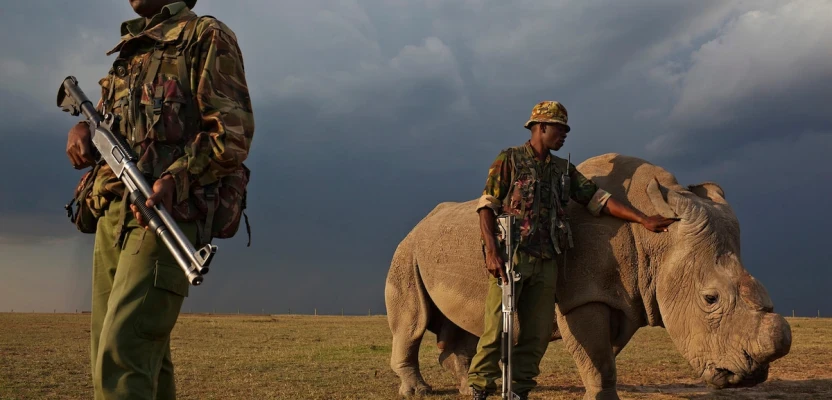
The dark web, an elusive part of the internet, has become a haven for illegal activities, including the illicit trade of wildlife. This hidden marketplace operates beyond the reach of conventional law enforcement, making it a significant threat to global biodiversity and animal welfare.
What is the Dark Web?

The dark web is a hidden part of the internet that is not indexed by standard search engines like Google, Bing, or Yahoo. It operates on networks that require specific software to access, such as Tor (The Onion Router). This layer of the internet is intentionally concealed and is used for a variety of purposes, some of which are legal, but many of which are not.
The dark web utilizes encryption and anonymizing tools to protect users' identities and activities. When a person accesses the dark web through Tor, their internet traffic is routed through multiple servers around the world, obscuring their location and identity. This process makes it challenging for authorities to track users' activities, contributing to the dark web's reputation as a hub for illicit activities.
While the dark web is often associated with illegal activities, it also serves legitimate purposes. For instance, journalists and whistleblowers use it to communicate securely and anonymously. Activists in repressive regimes rely on the dark web to bypass censorship and surveillance.
However, the dark web is notorious for hosting marketplaces where illegal goods and services are sold, including drugs, weapons, counterfeit money, and stolen data. The anonymity it offers makes it an attractive platform for cybercriminals and other illicit actors.
The scale of illegal wildlife trade on the Dark Web

The illegal wildlife trade is a global issue that threatens biodiversity and contributes to the decline of many endangered species. While traditional markets for wildlife trafficking have existed for centuries, the advent of the dark web has significantly expanded the scope and scale of this illicit trade.
Types of wildlife sold illegally
Endangered species
The dark web has facilitated the trade of many endangered species, which are highly sought after for their parts and perceived value. Key examples include:
- Elephants. Poached primarily for their ivory, which is carved into ornaments and jewelry.
- Rhinoceroses. Hunted for their horns, falsely believed to have medicinal properties.
- Tigers. Targeted for their skins, bones, and other body parts used in traditional medicine and as status symbols.
Exotic pets
A significant portion of the dark web wildlife trade involves the sale of exotic pets. These animals are often captured from the wild and sold to collectors and enthusiasts. Commonly traded exotic pets include:
- Reptiles. Such as snakes, turtles, and lizards.
- Birds. Including parrots, macaws, and other rare species.
- Primates. Small monkeys and other primate species are sought after for their uniqueness and perceived novelty.
Rare plants
The illegal trade isn't limited to animals. Rare and protected plant species are also trafficked for their ornamental value or supposed medicinal benefits. Orchids, succulents, and certain cacti are among the most frequently traded plants on the dark web.
Financial impact of illegal wildlife trade
The financial impact of illegal wildlife trade on the dark web is substantial. Estimates suggest that the global illegal wildlife trade is worth billions of dollars annually, with a significant portion facilitated through dark web transactions. This trade undermines legitimate economies and conservation efforts, funneling money into criminal networks instead of supporting sustainable development and environmental protection.
Consequences of illegal wildlife trade
Ecological impact
The illegal trade of wildlife on the dark web has severe ecological consequences. Removing species from their natural habitats disrupts ecosystems, leading to a cascade of negative effects. For example, the poaching of apex predators like tigers can result in the overpopulation of prey species, which in turn affects vegetation and the broader ecological balance.
Animal welfare concerns
Animals trafficked via the dark web often endure horrific conditions. They are smuggled in cramped, unsanitary containers, leading to high mortality rates. Those that survive the journey face a life in captivity, far removed from their natural environments and deprived of the opportunity to exhibit natural behaviors.
Public health risks
The illegal wildlife trade also poses significant public health risks. Many trafficked animals carry diseases that can be transmitted to humans, contributing to the emergence of zoonotic diseases. The COVID-19 pandemic has underscored the dangers of such interactions, highlighting the need for stricter controls on wildlife trade to prevent future outbreaks.
Combating illegal wildlife trade on the Dark Web
Law enforcement challenges
- Anonymity. The dark web's anonymity makes it difficult to trace the identities of buyers and sellers.
- Jurisdictional issues. The global nature of the internet means that transactions can occur across multiple jurisdictions, complicating enforcement efforts.
- Resource limitations. Many law enforcement agencies lack the resources and expertise to effectively monitor and investigate dark web activities.
Technological solutions
- Artificial Intelligence (AI). AI and machine learning algorithms can help identify patterns and predict illegal activities on the dark web.
- Blockchain. Blockchain technology can enhance transparency and traceability in wildlife supply chains, making it harder for illegal products to enter the market.
- Collaboration. International collaboration between law enforcement agencies, NGOs, and tech companies is crucial for developing effective strategies to combat wildlife trafficking on the dark web.
Legal and regulatory measures
- Stronger legislation. Enacting stricter laws and penalties for wildlife trafficking can deter potential offenders.
- Regulation of online platforms. Regulating online marketplaces and social media platforms to prevent the sale of illegal wildlife products.
- Awareness campaigns. Public awareness campaigns can educate consumers about the consequences of buying illegal wildlife products and promote responsible behavior.
Case studies
The illegal wildlife trade on the dark web is a global issue that demands coordinated efforts and innovative strategies to tackle effectively. Case studies from around the world illustrate how law enforcement agencies, NGOs, and international collaborations have made significant strides in addressing this hidden crisis.
Operation Cobra
Operation Cobra is one of the most notable examples of international cooperation to combat illegal wildlife trade. Conducted in multiple phases, this operation involved law enforcement agencies from over 30 countries across Africa, Asia, and Europe. The aim was to target and dismantle networks involved in the trafficking of endangered species.
The operation led to the arrest of hundreds of suspects and the seizure of substantial quantities of illegal wildlife products, including ivory, rhino horns, and tiger parts.
Operation Thunderstorm
Operation Thunderstorm, coordinated by INTERPOL and the World Customs Organization (WCO), was a month-long operation aimed at tackling wildlife and forestry crime. It involved law enforcement agencies from 92 countries and targeted both physical and online markets, including the dark web.
The operation resulted in the seizure of thousands of wildlife specimens, including live animals, plants, and products derived from endangered species.
The role of NGOs
Non-governmental organizations (NGOs) play a crucial role in combating illegal wildlife trade. Two prominent NGOs, the World Wildlife Fund (WWF) and TRAFFIC, have been at the forefront of these efforts.
World Wildlife Fund (WWF)
The WWF has been instrumental in raising awareness, conducting research, and supporting law enforcement efforts. Their initiatives include:
- Training programs. WWF provides training for law enforcement officials on how to identify and combat wildlife trafficking.
- Public campaigns. They run campaigns to educate the public about the impacts of illegal wildlife trade and promote sustainable practices.
TRAFFIC
TRAFFIC focuses on monitoring wildlife trade and providing critical data to support enforcement actions. Their key contributions include:
- Market surveys. Conducting surveys of online and offline markets to identify trends in illegal wildlife trade.
- Policy advocacy. Working with governments to strengthen legislation and enforcement mechanisms to combat wildlife trafficking.
Conclusion
The illegal trade of wildlife on the dark web is a complex and multifaceted issue that poses significant threats to biodiversity, animal welfare, and public health. Combating this illicit trade requires a combination of technological innovation, international collaboration, and robust legal frameworks. By addressing the root causes and implementing effective strategies, we can protect endangered species and preserve our planet's ecological balance for future generations.
FAQs
How does the dark web facilitate illegal wildlife trade?
The dark web allows traffickers to buy and sell wildlife products anonymously. Transactions are often conducted using cryptocurrencies, making it difficult for authorities to trace and intercept these illegal activities. The encrypted and hidden nature of the dark web provides a secure platform for these transactions.
What challenges do law enforcement agencies face in combating illegal wildlife trade on the dark web?
Law enforcement agencies face several challenges, including the anonymity of dark web users, jurisdictional issues as transactions span multiple countries, and resource limitations. The hidden nature of the dark web makes it difficult to track and intercept illegal activities.
How can individuals help in the fight against illegal wildlife trade?
Individuals can support conservation efforts by donating to or volunteering with organizations dedicated to wildlife protection. Reporting suspicious wildlife products online to authorities and spreading awareness about the impacts of illegal wildlife trade are also vital steps. Educating oneself and others about responsible practices can contribute to the global effort to combat wildlife trafficking.





Comments 0